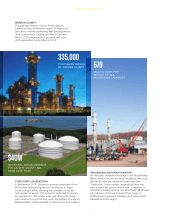Dominion Power 2014 Annual Report Download - page 11
Download and view the complete annual report
Please find page 11 of the 2014 Dominion Power annual report below. You can navigate through the pages in the report by either clicking on the pages listed below, or by using the keyword search tool below to find specific information within the annual report.
DOMINION RESOURCES, INC.
9
COVE POINT LIQUEFACTION PROJECT
COVE POINT LIQUEFACTION
Current Facility
• Located on Chesapeake
Bay in Lusby, Md.
• 14.6 billion cubic feet
storage capacity
• Supertankers can
access pier
• Connects to multiple gas
supply basins
Project Scope
•$3.4 – $3.8 billion
• Permits received
• Construction underway
• Liquefaction capacity fully
subscribed for 20 years
• Service date: Expected
late 2017
PROJECT BENEFITS
Environmental
• Uses existing footprint
• Protects 1,000-acre
nature preserve
International
• Provides India, Japan
source of natural gas
• Advances U.S.
geopolitical interests
• Reduces trade deficit
Economic
• Average of 1,000
construction jobs per year
over three years
• 75 permanent jobs at site
• Supports thousands
of short- and long-term
jobs in mid-Atlantic,
Appalachian Basin
• Expected to contribute
additional $40 million
annually in revenue to
Calvert County, Md.
LNG SUBSCRIBERS
ST Cove Point, LLC
• Joint venture between
Sumitomo Corporation and
Tokyo Gas Co., Ltd.
• Japanese offtakers
include large gas and
electric utilities
GAIL Global (USA) LNG LLC
• U.S. subsidiary of GAIL
(India) Limited
• One of the largest gas
processing, distribution
companies in India
‘WIN’ FOR CLEAN AIR
In everything Dominion does, we are aware of
our environmental impact and work tirelessly
to minimize that impact. The Cove Point
liquefaction project can help reduce atmospheric
emissions of greenhouse gases (GHG).
According to a study by ICF International,
supplying India and Japan with LNG rather
than coal would result in 43–52 percent
fewer GHG emissions in those nations.
The station also works to minimize its local
impact. While natural gas will be used to drive
the compression and supercooling process, our
recovery of turbine exhaust heat will produce
electricity necessary to run the plant—thereby
eliminating the need for additional emissions.
Cove Point can reduce
GHG emissions globally.
























